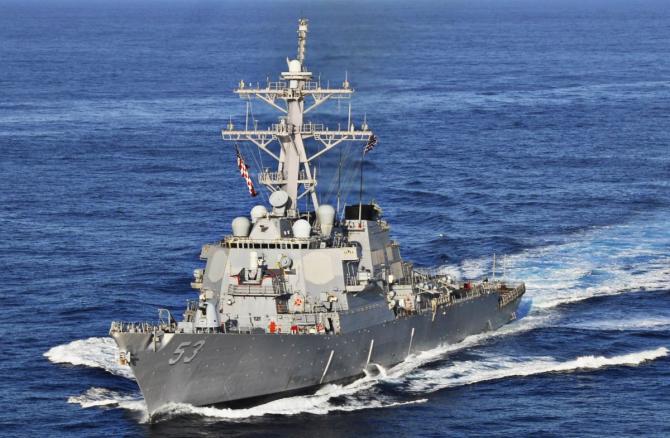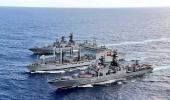'Movement of naval forces at sea is often more than just perfunctory deployment -- reading the messages that they send is important,' alerts Vice Admiral Premvir Das (retd).

Just recently, an American guided missile destroyer, the USS John Paul Jones, transited through the waters in India's Lakshadweep area falling within our Exclusive Economic Zone (EEZ).
The warship was on passage from the Persian Gulf to the Malacca Straits in its normal deployment but its superiors -- the 7th Fleet to which it belonged -- chose to call it a Freedom of Navigation Operation (FONOPS).
It is hardly likely that the Fleet headquarters would make such an articulation on its own and without advice from its own higher authority.
The Indian government formally protested that its prior permission -- even information -- to transit through the Indian EEZ had not been taken.
The response from the US government (Pentagon) has been crisp and curt. The warship was moving through 'International Waters' where freedom of movement and safe navigation was an inherent right, which the US had a duty to enforce.
It is interesting to examine why the Americans acted the way they did and why we responded in the manner that we did.
By right, every coastal nation has a stretch of water termed its Territorial Sea. This extends up to 12 miles from the coast. Every foreign warship wishing to move through this space needs to seek permission of the coastal country.
Then there is the EEZ. This extends up to 200 miles from the continental shelf of the coast. Within this space, the coastal State alone has sovereign rights of economic exploitation of underwater resources, but for navigation, the EEZ forms part of international waters within which ships of all nations have freedom of movement and for which permission of the coastal state is not needed; even prior information is at best an act of courtesy.
This is duly specified in the United Nations Laws of the Sea (UNCLOS) of 1982.
We are a signatory to this convention -- the US is not -- but with a caveat that deployment of a warship through its EEZ would need to be notified.
Other countries have made their own modifications but ability to enforce them is what determines their relevance.
This is not the first occasion that a foreign warship has transited through our EEZ without informing us or taking concurrence to do so.
The issue here is not that the US destroyer took this route but that the superior authority chose to respond in the terse manner that it did.
There have been instances when full US task forces comprising aircraft carriers and nuclear submarines have exercised in our EEZ, but that was in the period of the Cold War when our relations were tense if not adversarial.
For example, a task force led by the aircraft carrier USS John F Kennedy, operated within 100 miles south of Diu in 1982 and was kept under surveillance by Indian Navy aircraft, but that was that.
For this so-called FONOPS to have been brought into play now, when the two are close strategic partners in the Indo-Pacific, merits some discussion.
First, some compliments are due to our maritime forces for having maintained due surveillance of our EEZ, which led to the US warship being located.
Some time ago, a chief of the naval staff had stated that every entry and exit of a Chinese warship in and out of the Indian Ocean Region through the Malacca Strait was kept track of. This recent incident has proved the credibility of that claim.
Whether through satellite reconnaissance or through more proximate aircraft, we are, indeed, able to keep, under surveillance, movement of vessels in the area of our interest.
If more accretion to such capability is projected, as reported, it is clearly a legitimate need.
To this should be added the ability to respond to such detections and not only through diplomatic notes.
In the past, our ships have intercepted intruding craft and got them to move out of our EEZ.
Augmenting this maritime air power, including its projection at distances must, therefore, be the sine qua non of our sea-going forces.
Aircraft carriers are pivotal to this role, which only highlights the need for a minimum of three such ships.
Hopefully, the Indian Navy and the government are cognisant of this need.
The second aspect of the incident is the possible political messaging that is sought to be made.
The desired information to India could have been transmitted at the lowest possible level with no disadvantage to either country; yet the US chose to bring it to headline status leading to negative reaction in India, which could not have been unanticipated.
So, the Indian reaction was expected ,but the supposed benefits apparently outweighed it.
What could be the reason, it may well be asked.
One, to convey a signal to the Chinese that it is not only in their part of the world where America would exert its rights through FONOPS, but also elsewhere, including in waters claimed as their own by friendly countries, read India.
So, if there are some smiles in Beijing, it is not without reason.
The recent visit of the Russian foreign minister to India and the impression conveyed that the S400 AMD system was on track could also have been a factor; it is not certain if the first deliveries will not lead to some type of sanction against India being brought into effect by the Biden administration.
Another reason could be that the Quad etc notwithstanding, there should be no mistaking the superior position of the US in any such alliance.
The answers to these questions will take some time to emerge.
The bottom line is that treating the routine passage of one of its warships through the Indian EEZ as FONOPS is a well-considered American move weighing all pros and cons and one which could not have been an 'off the cuff'; action. We should analyse it carefully.
Movement of naval forces at sea is often more than just perfunctory deployment -- reading the messages that they send is important.
Vice Admiral Premvir Das (retd) has served as member of the National Security Advisory Board.











